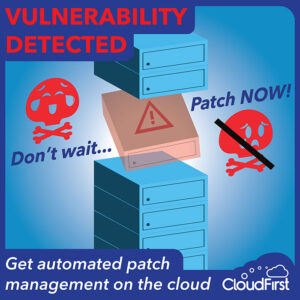Could your applications pass an internal security audit right now? If the thought of an audit sends a shiver down your spine, you’re in the right place.
Patch management—sometimes grouped with vulnerability management—is a key part of maintaining the security of mission-critical applications and protecting sensitive data.
You may be wondering: What exactly does patch management entail?
In basic terms, patch management is about balancing cybersecurity concerns with your organization’s operational needs. Patches can be applied to close security vulnerabilities, optimize software and device performance, and add new product features.
Automated patch management takes care of all of this for you and reduces your company’s attack surface. Once you enable an automated patch management program, software updates and patches are installed to your system automatically.
Speed is a critical aspect of patching vulnerabilities. With automated patch management, you get the rapid response times you need without putting undue pressure on your team.
Let’s look more closely at how patch management impacts security—and why regular maintenance is crucial, not optional.
The repercussions of not implementing patches: Don’t leave the door open

The IBM X-Force Threat Intelligence Index 2021 reported that one-third of all data breaches resulted from unpatched vulnerabilities—these known vulnerabilities sit there, unpatched, like a blinking “ENTER HERE” sign for bad actors to exploit.
Patches primarily serve as roadblocks for everything from malware to ransomware. In 2017, WannaCry ransomware spread via a Microsoft Windows vulnerability for which a patch had been issued. Cybercriminals attacked networks where admins had neglected to apply the patch, infecting more than 200,000 computers in 150 countries.
In the first quarter of 2021, the number of organizations that suffered WannaCry ransomware attacks increased by 53%, stemming from the original vulnerability for which a patch had long been available.
Bad actors comb through applications looking for unpatched software—low-hanging fruit in terms of an access point. You don’t have to make their day easier; all you have to do to reduce the risk of them exploiting those vulnerabilities is implement the right tool.
Slacking on patch management isn’t only an irresponsible approach to cybersecurity; it can also lead to severe repercussions for your brand’s reputation and your bottom line.
Though the WannaCry incident was considered a black swan event across cyberspace, a threat doesn’t have to reach that status to be taken seriously.
Even the smallest crack can lead to serious breaches if not addressed fast enough. With manual patch management, this becomes a slog of endless audits.
The risks of patch management errors
An important rule of patch management is: Always deploy your patches in a test environment before a live application.
If you skip this step, you risk massive errors, extended downtime, and more. If we look at the recent Crowdstrike outage, it all stemmed from a faulty patch that was not properly tested before being deployed.
This one slip-up caused a global tech outage costing Fortune 500 companies alone more than $5B in direct losses. Major airlines such as American and United were among the most affected, losing a collective $860M and leaving passengers frustrated and stranded.
95% of security incidents are caused by human error, including the Crowdstrike outage. But don’t despair—with the right automated patch management tools and proper procedures, it’s easy to avoid becoming a statistic.
The different types of patches (and why they’re important)
Patches overall have similar goals—to improve and secure applications—but there are three basic types of patches you should know:
- security patches
- bug fixes/software patches
- feature updates
Security patches are a regular and straightforward way to ensure your devices, software, and apps are prepared for battle against the latest threats. As the US Chamber of Commerce says, “These updates literally ‘patch’ a hole in your defense, preventing a hacker or piece of malware from exploiting a way into your network.”
Bug fixes and software patches typically come from vendors. That’s why it’s critical to stay up-to-date with the latest patch releases. These software updates could be to address glitches in performance or to remedy application vulnerabilities.
Feature updates allow software developers to upgrade and fine-tune their products and services. These are typically small, ongoing improvements rather than significant overhauls, but they are still key players for ensuring everything is operating to the best of its abilities.
Each patch type is relevant for maintaining secure applications, and each helps you avoid becoming the target of bad actors on the prowl for loose patch management.
These patches are typically implemented manually, which, depending on the size of your organization, can be a tall order.
Security patches may be the most important. But any of these patches, if you fail to implement them, could become a security risk. Operating on unpatched, outdated software leads to a higher chance of infiltration or vulnerability exploitation by bad actors.
Automated patch management conducts regular audits and alerts your team to vulnerabilities, available software updates, and more. This ensures the safety of your systems without all the manual work of traditional patch management.
How HCL BigFix’s automated patch management improves cybersecurity automation

HCL BigFix handles all aspects of patch management and is compatible with all operating systems including IBM Power, bringing seamless, automated patch management to your organization.
To be more specific, HCL BigFix takes care of:
- monitoring and researching software vendor patch sources
- testing and packaging patches
- analyzing environments for missing patches
- detecting missing patches
- continuous auditing for patch compliance
- realtime reports on patch compliance
- confirming successful patch deployment
- deploying patches to test environments
- patch implementation across all managed endpoints
This means all you need to worry about is prioritizing patches and change management.
Having that type of support in your back pocket is a game changer in more ways than one. No more worrying about patching across different servers running different versions of software. Automated patch management has your back.
Automated patch management has been reported to increase a patching compliance rating from 65% to 99% and achieve $6M in cost savings for an enterprise company with 25K servers.
Automated patching deploys patches immediately, closing security gaps faster and preventing potential breaches. Whereas manual patching can take precious time, automated patch management gets the job done without the hassle—or the risk of patch fatigue.
Ponemon Institute reported that 56% of organizations who implemented automated patch management experienced significantly shorter response times to vulnerabilities, which makes patch automation an important part of any business continuity plan. Say goodbye to downtime incurred while your IT team applies a patch manually.
When people are tired, rushed, or overencumbered, mistakes happen. Risk increases. That’s a given. The less stressed and burnt out your IT team is, the more likely your applications are to stay safe, secure, and properly patched.
Remember to shore up your defenses
If you think of your applications as a castle, patch management maintains the stone walls encircling your property. Without regular repairs and attention, you could end up with a chink in your armor—or worse, it could crumble entirely.
ezAutomate ensures a consistent standard for IT infrastructure and security, including:
- deploying and distributing software
- updating operating systems and applications
- managing software licensing
- monitoring and optimizing IT processes
- detecting and remediating vulnerabilities
Ensure your wall is Fort Knox–level secure. We can even add a few crocodiles to your moat to sweeten the deal. Don’t hesitate to reach out to CloudFirst to learn more!

